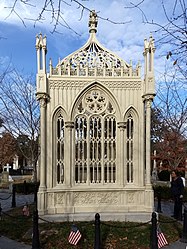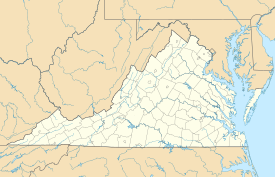James Monroe Tomb
| James Monroe Tomb | ||
|---|---|---|
| National Register of Historic Places | ||
| National Historic Landmark | ||
| Historic District Contributing Property | ||
|
James Monroe Tomb (2017) |
||
|
|
||
| location | Hollywood Cemetery , Richmond , Virginia | |
| Coordinates | 37 ° 32'6 " N , 77 ° 27'20" W | |
| Built | 1858 | |
| architect | Albert Lybrock | |
| Architectural style | Gothic revival | |
| NRHP number | 71001044 | |
| Data | ||
| The NRHP added | November 11, 1971 | |
| Declared as an NHL | November 11, 1971 | |
| Declared as CP | November 12, 1969 | |
The James Monroe Tomb is the tomb for former American President James Monroe and is located in Hollywood Cemetery in Richmond , Virginia . As a monument of national importance, it has the status of a National Historic Landmark .
Building description
The cast iron tomb and its immediate surroundings are marked out by a low wall ring. The James Monroe Tomb has a cage-like shape and a rectangular base of almost 4 × 2.75 m. It is designed in lush neo-Gothic and stands on a hill overlooking the James River . The lattice walls of the tomb are shaped like lancet windows , with the longer front facades each having two flanking lancet arches that are slightly lower. The middle lancet arch has a rose window shape in the uppermost field , under which three pointed arches open. On the side of the lattice walls have narrow pillars that carry a small tabernacle . The roof is an open and curved pointed arch canopy . Inside is the simple sarcophagus of James Monroe, which is made of granite .
The architect Albert Lybrock (1827–1886), a native German, used cast iron as a building material for the James Monroe Tomb, since the lush neo-Gothic design in the style of open tracery windows was not possible with a stone-exposed object. Wood and Perot manufactured the cast iron components in Philadelphia . As far as the building material and design are concerned, Lybrock was under the stylistic influence of larger construction projects with cast iron such as the dome of the United States Capitol , which had been completed shortly before.
history
Monroe was buried on July 7, 1831 - three days after his death - in New York City in the New York Marble Cemetery . In 1856 in New York plans were discussed to erect a tomb for him. Against this background, the governor of New York asked his Virginia counterpart Henry A. Wise whether Virginia, the home of Monroe, would not be interested in relocating the former president's grave. When the Virginia General Assembly approved funds for this venture, the remains of Monroe were escorted to Richmond on the steamship Jamestown by a New York regiment . There the bones were buried in Hollywood Cemetery in 1858. The governors of Virginia and New York were present at the solemn burial ceremony. The following year the construction of the James Monroe Tomb was completed.
On November 12, 1969, the James Monroe Tomb was listed as a Contributing Property of the Historic District Hollywood Cemetery on the National Register of Historic Places (NRHP). On November 11, 1971, the tomb received the status of a National Historic Landmark , which meant that it was included in the NRHP as an independent monument.
In Richmond, where the tomb is known by the nickname “birdcage” (German: “Vogelkäfig”), the restoration of the cast iron housing began shortly before the 200th anniversary of Monroe's election as president . Among other things, the original lighter color was restored. For this construction project, which was completed by 2017, the tomb, with the exception of the sarcophagus, was dismantled and transported to a workshop in the south of Richmond. This is where the actual restoration took place.
Web links
Remarks
- ^ WB Morton III .: James Monroe Tomb: Nomination Form . In: National Register of Historic Places database . National Park Service , August 14, 1971, accessed March 31, 2018 (English, 302 KB), p. 2.
- ^ WB Morton III .: James Monroe Tomb: Nomination Form . In: National Register of Historic Places database . National Park Service , August 14, 1971, accessed March 31, 2018 (English, 302 KB), p. 3.
- ^ Harry Ammon: James Monroe: the Quest for national identity . Paperback edition. University Press of Virginia, Charlottesville 1990, ISBN 0-8139-1266-0 , p. 572.
- ↑ Things To See , Hollywood Cemetery website .
- ↑ WB Morton III: James Monroe Tomb: Nomination Form . In: National Register of Historic Places database . National Park Service , August 14, 1971, accessed April 1, 2018 (PDF 302 KB), p. 4.
- ↑ Hollywood Cemetery on the National Register Information System. National Park Service , accessed March 31, 2018.
-
↑ Listing of National Historic Landmarks by State: Virginia . National Park Service , accessed March 31, 2018.
Monroe, James, Tomb on the National Register Information System. National Park Service , accessed March 31, 2018. - ↑ Graham Moomaw: Monroe's 'birdcage' tomb at Hollywood Cemetery to be repaired ahead of bicentennial , Richmond Times-Dispatch , September 29, 2015, accessed March 31, 2018.
- ↑ Joan Tupponce: Trade Names: Chase Architectural Metal work ranges from custom-made railing system to historic renovations , Richmond Times-Dispatch , April 30, 2017 accessed March 31, 2018th

